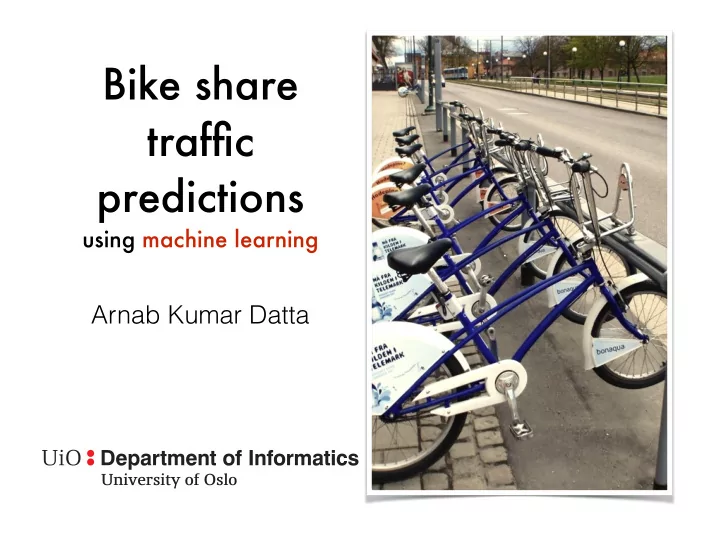

Bike share traffic predictions using machine learning Arnab Kumar Datta
Agenda • Introduction to bike-sharing • Motivation and vision • A short introduction to machine learning • Overview of software • Results • Conclusion
Bike-sharing
Why bike-sharing
The problem
Above: A customer reviews London’s bike-share system on the tripadvisor website
Above: A customer reviews Washington’s bike-share system on the tripadvisor website
Users currently have real-time systems
The vision “I will be downtown at 8 am on Monday. Will the bike station be full?”
Related work • Data science for social good (predicting bike-share usage in Chicago’s Divvy bike system) • Jake VanderPlas (modelling the effects of weather on bike usage in Seattle)
Machine learning
Machine learning algorithm Training set Test set Learned estimator Predictions for test set
Training set Sunny Downtown Tuesday 8:00 AM 11 bikes Sunny Downtown Tuesday 11:00 AM 0 bikes Rainy Downtown Tuesday 8:00 AM 2 bikes Sunny Downtown Tuesday 11:00 AM 2 bikes Sunny Downtown Tuesday 1:00 PM 1 bike
Test set Sunny Downtown Tuesday 8:00 AM 11 bikes Sunny Downtown Tuesday 11:00 AM 1 bike Sunny Downtown Tuesday 8:00 AM 10 bikes Sunny Downtown Tuesday 1:00 PM 2 bikes Sunny Downtown Tuesday 2:00 PM 1 bike
Software overview
Libraries used • Scikit-learn (machine learning algorithms) • Pybikes (data collection) to collect data from the Washington bike-share system
Machine learning algorithms
Decision Trees
Sunny Rainy Morning Noon Morning Noon 10,11 0,1 0,1 0,0 12,13 2,3 2,3 0,0
Random Forests
Random Forests • Lots of decision trees • Output given by the average of the output of all trees in the forest • Cannot overfit by adding more trees (note: RF can overfit on noisy datasets when there are too few trees!)
Ada Boost
AdaBoost • Analogy: student preparing for an exam in physics • Topics covered: classical physics, thermodynamics, electromagnetism, quantum physics • They start by doing a practice exam • They notice they didn’t do well on electromagnetism. Ignore all other topics until they grasp electromagnetism. • Do another practice exam • Repeat… until it’s time for the exam
Thesis contribution
Data collection using Pybikes
Feature selection
Why is the “epoch” so important? A missing time-related feature that has not been accounted for.
Genetic algorithms • Hyperparameters - algorithm configuration • Can use GA to pick the “optimal” feature set that provides the best prediction performance • GAs did not improve the accuracy over manually picked hyperparameters
Results
A customizable machine-learning package for predicting bike-share usage
Improvements on existing solutions?
Error metric: RMSE
Improvement Error (RMSE) Poisson model (DSSG) Decision Tree Regressor Random Forest Regressor Ada Boost Regressor 0 1,75 3,5 5,25 7
Further work
The vision “I will be downtown at 8 am on Monday. Will the bike station be full?”
Recommend
More recommend